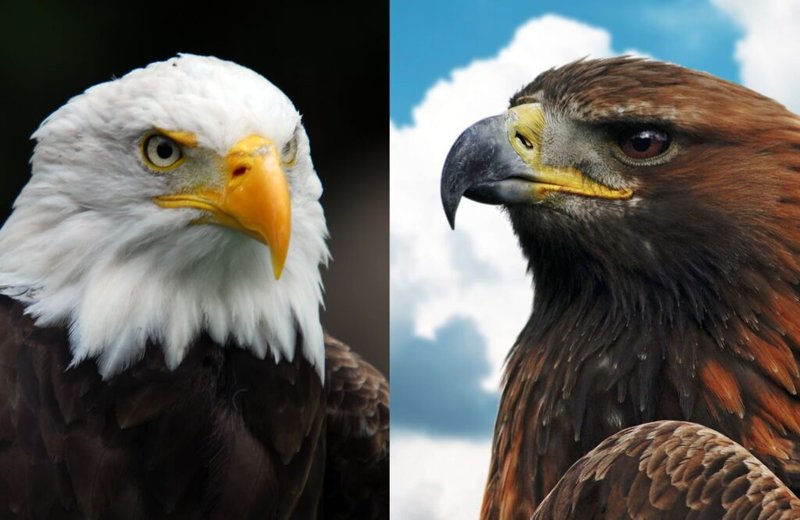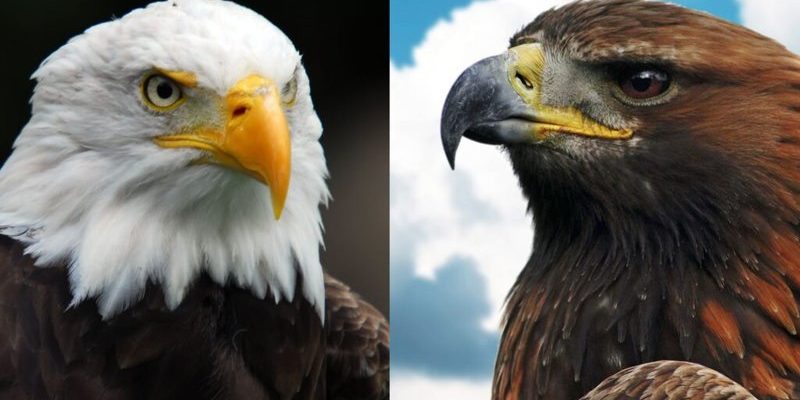
So, grab a cup of coffee, and let’s dive into some birdwatching 101! In this guide, we’ll explore the key differences between the bald eagle and its similar counterparts: the golden eagle, the osprey, and the white-tailed eagle. Not only will this help you identify these birds more easily, but it might also deepen your appreciation for each of their roles in nature.
Bald Eagle vs. Golden Eagle
The bald eagle and the golden eagle are often mistaken for one another, especially from a distance. However, there are some notable differences that can help you tell them apart. For starters, the bald eagle has a white head and tail, while the golden eagle showcases a striking golden brown plumage with lighter feathers on its nape. You can think of it like how two siblings can look alike but still have their unique features.
Another point of distinction is their size. Golden eagles are generally larger than bald eagles, with a wingspan that can reach up to 7.5 feet. The bald eagle’s wingspan, on the other hand, typically ranges from 6 to 7.5 feet. If you spot an eagle soaring overhead, measuring its wingspan could be a quick way to figure out which one you’re looking at!
The habitats of the two species also differ slightly. Bald eagles prefer areas near large bodies of open water, like lakes or rivers, where they can find plenty of fish. Golden eagles are more versatile; they thrive in mountainous regions and open fields. So, if you’re hiking in the Rockies and spot a majestic bird on a cliff, there’s a good chance it’s a golden eagle.
Bald Eagle vs. Osprey
Now let’s chat about the osprey, another bird that you might confuse with the bald eagle. While both birds are skilled fishers, they have different physical characteristics. The osprey is generally smaller, with a more slender body and a distinctive black eye patch that gives it a fierce look—almost like it’s always ready for action.
One major difference is their hunting style. Bald eagles are known for their powerful swoops and grabs, often stealing fish from ospreys—yes, they can be quite the bullies! In contrast, ospreys dive into the water feet first, relying on their keen eyesight to spot fish. When you see an osprey in action, it’s like watching a well-coordinated athlete in a splash competition.
In terms of nesting, ospreys build their nests near water, often on high structures like telephone poles or tall trees. Bald eagles, however, prefer to construct larger nests that can be reused for many years, usually situated in tall trees. So, keep an eye out for these nests if you’re birdwatching!
Bald Eagle vs. White-tailed Eagle
The white-tailed eagle is another bird that could be mistaken for the bald eagle, especially in regions where their habitats overlap. One of the fastest ways to tell them apart is, you guessed it, by their tails! The white-tailed eagle has a more uniformly brown body with a broad, wedge-shaped tail that’s—wait for it—white. Meanwhile, the bald eagle’s tail is completely white, contrasting sharply with its dark body.
In addition to their tail differences, the two species vary in size. White-tailed eagles are generally robust and can weigh more than bald eagles. They share a similar wingspan of about 6 to 8 feet, which can make it tricky to identify them in flight. But if you catch a glimpse of the wings and notice that broad tail, you might be looking at a white-tailed eagle.
Their feeding habits also differ. While both birds will eat fish, the white-tailed eagle has a broader diet that includes carrion and small mammals. This adaptability can be a survival advantage in certain habitats, especially when fish is scarce.
Physical Differences
When we line up the bald eagle, golden eagle, osprey, and white-tailed eagle, the differences in their plumage, size, and features become clearer. Here’s a quick rundown:
- Bald Eagle: White head and tail, yellow beak, dark brown body.
- Golden Eagle: Dark brown body with golden feathers on the nape, larger size.
- Osprey: Slender, white head with a black eye patch, dark wings, smaller size.
- White-tailed Eagle: Uniformly brown with a white tail, robust build.
Recognizing these differences can really enhance your birdwatching experience. Each eagle has its own unique story and role in the ecosystem, making them all worth knowing.
Habitat Preferences
Understanding where each of these birds prefers to live can help you spot them more easily. Bald eagles, as earlier mentioned, are often found near lakes, rivers, and coastal areas. They need large trees for nesting and prefer habitats where they can easily access their primary food source—fish.
Golden eagles can be found in a variety of landscapes, including open fields, mountain ranges, and grasslands. Their adaptability to different environments enables them to thrive in rugged terrain, which is often where you’ll spot them soaring high above the ground.
Ospreys, on the other hand, are generally found close to water, nesting near rivers, lakes, or coastal areas. Their nests might be visible on platforms or tall structures like power poles, which provide a perfect lookout for hunting.
Lastly, white-tailed eagles prefer large bodies of water and can often be spotted near rivers, lakes, and coastal areas, just like their bald cousins. Knowing their favorite hangouts can make your birdwatching adventures more rewarding.
Behavior and Diet
Each eagle has its own unique hunting and feeding behaviors that reflect its adaptability to its environment. The bald eagle is well-known for its impressive fishing skills. They often hunt from a perch, watching for fish near the water’s surface and then launching into a powerful dive to snag their meal. They can also be opportunistic feeders, sometimes stealing food from other birds like ospreys.
Golden eagles are skilled hunters, often preying on small to medium-sized mammals. They use their sharp talons to catch prey mid-flight or knock them down from a high vantage point. It’s both thrilling and effective, showcasing their adaptability beyond just fishing.
Ospreys are, as mentioned, expert fishermen. They have specialized feet with spiny pads that help grip slippery fish, making them highly efficient hunters. They typically eat fish almost exclusively, which makes them quite specialized compared to the more varied diets of other eagles.
White-tailed eagles are similar in their fishing habits to bald eagles, but they also eat carrion and small mammals. This versatility allows them to thrive in different environments, especially when fish isn’t readily available.
Conservation Status
Lastly, understanding the conservation status of these magnificent birds is crucial. The bald eagle was once listed as endangered due to habitat loss and the effects of pesticide use. However, thanks to conservation efforts and legal protections, their populations have rebounded significantly. It’s a true success story in wildlife conservation!
Golden eagles are generally stable but face threats from habitat loss and disturbances during breeding seasons, which makes monitoring their populations essential. Ospreys, too, have seen a resurgence thanks to similar efforts, although they remain vulnerable in some regions.
White-tailed eagles were once on the brink of extinction in some areas, but conservation initiatives have helped their numbers recover. Still, they face challenges from habitat degradation and pollution, which highlights the ongoing need for protective measures.
Wrapping Up the Eagle Experience
Now that we’ve explored the differences between the bald eagle and similar bird species, you should feel more prepared for your next birdwatching adventure. Whether you’re admiring the bald eagle’s iconic look or appreciating the hunting skills of the osprey, each bird plays a vital role in its ecosystem.
Being able to identify these majestic creatures not only enhances your experience outdoors but also fosters a deeper connection to nature. So, next time you’re out and about, keep your eyes peeled for these wonderful birds, and enjoy the beauty and diversity they bring to our skies!

